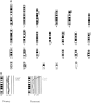hTERT gene amplification and increased mRNA expression in central nervous system embryonal tumors
- PMID: 12759234
- PMCID: PMC1868122
- DOI: 10.1016/S0002-9440(10)64311-8
hTERT gene amplification and increased mRNA expression in central nervous system embryonal tumors
Abstract
High-level gains at 5p15, a chromosomal region including the human telomerase catalytic protein subunit (hTERT) gene, have been documented in several medulloblastomas. We therefore analyzed hTERT gene dosage in a group of medulloblastomas and other embryonal brain tumors using differential PCR. Amplification of the hTERT locus was detected in 15 of 36 (42%) tumors examined. To correlate gene amplification with message level, we used real-time quantitative PCR to measure hTERT mRNA in 50 embryonal brain tumors. hTERT mRNA was detected in all but one of these cases, and mRNA level correlated significantly with gene dosage (r = 0.82). Log-rank analysis of survival data revealed a trend toward poor clinical outcomes in patients with medulloblastomas containing high hTERT mRNA levels, but clinical follow-up was relatively short and the association was not statistically significant (P = 0.078). Comparative genomic hybridization was used to further analyze the tumor with the greatest hTERT gene dosage and mRNA level, a recurrent medulloepithelioma. hTERT was amplified in the recurrent tumor but not in the primary lesion, suggesting this locus can be involved in tumor progression. Our data indicate that hTERT gene amplification is relatively common in embryonal brain tumors, and that increased expression of hTERT mRNA may be associated with biologically aggressive tumor behavior.
Figures



Similar articles
-
MYC messenger RNA expression predicts survival outcome in childhood primitive neuroectodermal tumor/medulloblastoma.Clin Cancer Res. 2001 Aug;7(8):2425-33. Clin Cancer Res. 2001. PMID: 11489822
-
High telomerase reverse transcriptase (hTERT) messenger RNA level correlates with tumor recurrence in patients with favorable histology Wilms' tumor.Cancer Res. 1999 Sep 1;59(17):4301-7. Cancer Res. 1999. PMID: 10485476
-
Detection of genetic and chromosomal aberrations in medulloblastomas and primitive neuroectodermal tumors with DNA microarrays.Brain Tumor Pathol. 2006 Apr;23(1):41-7. doi: 10.1007/s10014-006-0201-1. Brain Tumor Pathol. 2006. PMID: 18095118
-
[A new entity in WHO classification of tumors of the central nervous system--embryonic tumor with abundant neuropil and true rosettes: case report and review of literature].Zh Vopr Neirokhir Im N N Burdenko. 2011;75(4):25-33; discussion 33. Zh Vopr Neirokhir Im N N Burdenko. 2011. PMID: 22379850 Review. Russian.
-
Embryonal tumor with multilayered rosettes: Two case reports with a review of the literature.Neurol India. 2012 Jan-Feb;60(1):96-9. doi: 10.4103/0028-3886.93614. Neurol India. 2012. PMID: 22406791 Review.
Cited by
-
Anaplasia and grading in medulloblastomas.Brain Pathol. 2003 Jul;13(3):376-85. doi: 10.1111/j.1750-3639.2003.tb00037.x. Brain Pathol. 2003. PMID: 12946027 Free PMC article. Review.
-
The role of mRNA in the development, diagnosis, treatment and prognosis of neural tumors.Mol Cancer. 2021 Mar 5;20(1):49. doi: 10.1186/s12943-021-01341-7. Mol Cancer. 2021. PMID: 33673851 Free PMC article. Review.
-
Analysis of chromosome 19q13.42 amplification in embryonal brain tumors with ependymoblastic multilayered rosettes.Brain Pathol. 2012 Sep;22(5):689-97. doi: 10.1111/j.1750-3639.2012.00574.x. Epub 2012 Mar 6. Brain Pathol. 2012. PMID: 22324795 Free PMC article.
-
Hepatocyte growth factor enhances death receptor-induced apoptosis by up-regulating DR5.BMC Cancer. 2008 Nov 7;8:325. doi: 10.1186/1471-2407-8-325. BMC Cancer. 2008. PMID: 18992144 Free PMC article.
-
Telomeres and Telomerase in the Development of Liver Cancer.Cancers (Basel). 2020 Jul 24;12(8):2048. doi: 10.3390/cancers12082048. Cancers (Basel). 2020. PMID: 32722302 Free PMC article. Review.
References
-
- Kleihues P, Cavenee WK: Tumors of the Nervous System 2000. IARC Press, Lyon, France
-
- Ellison D: Classifying the medulloblastoma: insights from morphology and molecular genetics. Neuropathol Appl Neurobiol 2002, 28:257-282 - PubMed
-
- Feng J, Funk WD, Wang SS, Weinrich SL, Avilion AA, Chiu CP, Adams RR, Chang E, Allsopp RC, Yu J, Le S, West MD, Harley CB, Andrews WH, Greider CW, Villeponteau B: The RNA component of human telomerase. Science 1995, 269:1236-1241 - PubMed
-
- Harrington L, McPhail T, Mar V, Zhou W, Oulton R, Bass MB, Arruda I, Robinson MO: A mammalian telomerase-associated protein. Science 1997, 275:973-977 - PubMed
-
- Nakamura TM, Morin GB, Chapman KB, Weinrich SL, Andrews WH, Lingner J, Harley CB, Cech TR: Telomerase catalytic subunit homologs from fission yeast and human. Science 1997, 277:955-959 - PubMed
Publication types
MeSH terms
Substances
LinkOut - more resources
Full Text Sources

